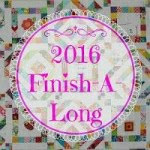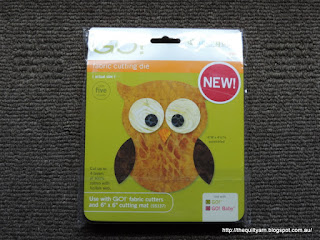I certainly started the New Year with a challenge to myself...to complete another Baby Blocks quilt using the dreaded Y-seam.
I have done the Baby Block design years ago
This started off as a great idea for a quilt but once I got into it, I nearly despaired. Those seams drove me nuts and it ended up becoming a little Mini wall hanging. I surprised myself in actually completing this. I still remember the cursing and carry on...needless to say, it took ages to complete.
You know how you sometimes look at a fabric and know exactly what you should do with it. Well, that was the case for me with that pretty Hippopotamus fabric (Urban Zoologie) by Ann Kelle for Robert Kaufmann fabrics. I thought of Baby Blocks straight away...mind you, initially I thought I might use the easier strip piecing method that I had found on the net, however then the call for a challenge took over.
There is a fair bit of information on the net about how to do y-seams but I need to write my own tutorial, so I can look back at it, if I ever want to do this again as there is a fair bit of variation on the net on how to press seams, how to align everything etc. I am determined to become proficient at this...I still got some 'bug' fabric that would also make a nice little baby quilt.
I used Sharon Hultgren's Easy Six Ruler from EZ Quilting to cut out the diamonds. If you do not own this, there is a wealth of info on the net on how to cut the shape at a 60 degree angle using a normal ruler. My blocks are made up of 3 1/2in diamonds.
Once cut out, I marked each piece 1/4in from the edge with a dot on the
wide angles only.
Mental note to self...use the blue water soluble marker pen rather than a black pencil mark!
 |
| Mark 1/4in seam allowance at the wide angles |
Precision is an absolute must here as you rely on these marks for alignment of the pieces and to get sharp and tidy points. I used a template that had holes for the 1/4in seam allowance to mark this as sloppiness set in when using a ruler.
 |
| My diamonds ready to be sewn together |
Align your pieces starting with the green top diamond onto the hippos....there are differing views on whether to start stitching at the blue mark 1/4in away from the top or whether to start at the longer end. My preference was to start stitching at the blue dot with a small stitch length, then stitch back and continue sewing down the seam increasing the stitch length to my normal stitch length again...all the way to the end.
 |
| Start stitching at the blue dot |
Some quilters also leave a 1/4in gap at the narrow angle on the bottom, however I found that this is not necessary. Once done, flip it open...do not press your seams with an iron at this stage. Remember, you are dealing with bias edges!
 |
| Finger press the seam allowance towards the Hippo fabric |
Again there was some variation...some people open up all of their seams, others do not. I tried several methods of pressing the baby block (once finished!) but stuck to my usual way and lightly finger pressed the seam towards the hippo fabric.
Now for the fun part...take the next diamond and place it on the top diamond
 |
| Stitching the Y-seam |
Do not overuse pins! Usually I am a pinner however I have found that pinning tends to distort your alignment and the less pins the better, so I used at a maximum two pins at this stage. Once you get the hang of this, it is actually easier to not use pins at all. To sew it, I flipped my piece over and started exactly at the previous seam line (again starting with a short stitch length, stitching back to anchor the point and then continuing with the seam at the normal stitch length). It is important that you get this right, i.e. do not stitch one stitch into the seam allowance as your seam will pull and not sit right. So no chain- piecing here, in fact, it is fairly intensive with having to align your needle to hit the right spot, going forward and then going back the exact number of stitches, adjusting your stitch length and dealing with bias edges, however with a bit of patience and calmness, all possible.
 |
| Sewing of last seam |
Now that you stitched the second seam, take the top piece and rotate it anti clockwise (covering the hippos), pulling the top green diamond out of the way as shown above. As previously, start stitching exactly at the existing 1/4in seam line, stitch forward and back a few stitches and sew all the way to the bottom. When completed, finger press the seams in a circular manner and open up the center, exposing three perfectly shaped little mini diamonds.
 |
| Press seams in circular manner |
And that's it, the completed baby block. I did press my block lightly and super carefully with the iron before I went on to the next phase, but this is a personal preference...as long as you don't overdo it and distort your blocks, I do not think it matters.
Part 2 will go into how to put the rows together and then join the rows in a zigzag fashion to complete the quilt. This is where the cursing is going to happen...happened to me this time again, however I am getting better (cursing has eased) and I am going to photograph this step-by-step as I could not find a lot of tutorials on actually putting all of this together. So I hope that you find this somewhat useful and will join me again in this little adventure.
Karin











































